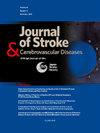Risk factors for clazosentan-induced fluid retention in subarachnoid hemorrhage from the Japanese adverse event database
IF 2
4区 医学
Q3 NEUROSCIENCES
Journal of Stroke & Cerebrovascular Diseases
Pub Date : 2025-04-02
DOI:10.1016/j.jstrokecerebrovasdis.2025.108296
引用次数: 0
Abstract
Background
Clazosentan, a selective endothelin receptor antagonist, is used to prevent cerebral vasospasm. We investigated patient characteristics and concomitant medications associated with an increased risk of clazosentan-induced fluid retention, the risk factors of which remain unknown.
Methods
We retrospectively reviewed cases of clazosentan-induced adverse drug reactions from the Japanese Adverse Drug Event Report (JADER) database, published by the Pharmaceuticals and Medical Devices Agency. We investigated the time course of fluid retention onset following clazosentan administration before analyzing whether specific patient characteristics and concomitant medications were associated with an increased risk of clazosentan-induced fluid retention.
Results
Among 241 cases of clazosentan use identified, fluid retention occurred in 114 (47.3 %). The median time interval from clazosentan initiation to onset of fluid retention was 3 days, and 88.7 % of fluid retention cases were reported within 1 week of initiation. Patients with fluid retention were older than those without; patients >70 years old accounted for 63.16 % of the cohort with fluid retention vs 44.1 % of the cohort without fluid retention. Fluid retention occurred more frequently in patients with concomitant use of fasudil hydrochloride, a conventional vasospasm drug in Japan, than in those without. Multivariate logistic regression analysis revealed that older age (>70 years) and concomitant use of fasudil hydrochloride remained independent risk factors for fluid retention.
Conclusions
Clazosentan-induced fluid retention occurred more frequently in older adult patients. Clazosentan combined with fasudil hydrochloride increased the incidence of fluid retention. These findings can guide pharmacological treatment of cerebral vasospasm in patients with subarachnoid hemorrhage.
来自日本不良事件数据库的克唑生坦引起的蛛网膜下腔出血液体潴留的危险因素
克拉生坦是一种选择性内皮素受体拮抗剂,用于预防脑血管痉挛。我们调查了与克拉生坦引起的液体潴留风险增加相关的患者特征和伴随药物,其风险因素尚不清楚。方法回顾性分析由药品和医疗器械管理局出版的日本不良药物事件报告(JADER)数据库中有关克唑生坦引起的药物不良反应的病例。在分析特定的患者特征和伴随的药物是否与克唑生坦诱导的液体潴留风险增加相关之前,我们调查了克唑生坦给药后液体潴留发生的时间过程。结果在241例使用克唑生坦的患者中,有114例(47.3%)发生体液潴留。从克唑生坦开始使用到液体潴留的中位时间间隔为3天,88.7%的液体潴留病例在开始使用的1周内报告。有液体潴留的患者比无液体潴留的患者年龄大;70岁患者占有体液潴留队列的63.16%,而无体液潴留队列的44.1%。同时使用盐酸法舒地尔(一种日本传统的血管痉挛药物)的患者比不使用盐酸法舒地尔的患者更容易发生液体潴留。多因素logistic回归分析显示,年龄较大(70岁)和同时使用盐酸法舒地尔仍然是液体潴留的独立危险因素。结论唑生坦引起的体液潴留在老年患者中更为常见。克拉森坦联合盐酸法舒地尔增加了液体潴留的发生率。这些发现对蛛网膜下腔出血患者脑血管痉挛的药物治疗具有指导意义。
本文章由计算机程序翻译,如有差异,请以英文原文为准。
求助全文
约1分钟内获得全文
求助全文
来源期刊

Journal of Stroke & Cerebrovascular Diseases
Medicine-Surgery
CiteScore
5.00
自引率
4.00%
发文量
583
审稿时长
62 days
期刊介绍:
The Journal of Stroke & Cerebrovascular Diseases publishes original papers on basic and clinical science related to the fields of stroke and cerebrovascular diseases. The Journal also features review articles, controversies, methods and technical notes, selected case reports and other original articles of special nature. Its editorial mission is to focus on prevention and repair of cerebrovascular disease. Clinical papers emphasize medical and surgical aspects of stroke, clinical trials and design, epidemiology, stroke care delivery systems and outcomes, imaging sciences and rehabilitation of stroke. The Journal will be of special interest to specialists involved in caring for patients with cerebrovascular disease, including neurologists, neurosurgeons and cardiologists.
 求助内容:
求助内容: 应助结果提醒方式:
应助结果提醒方式:


